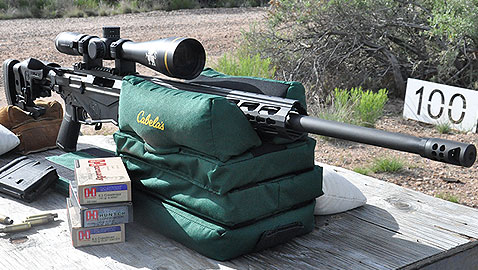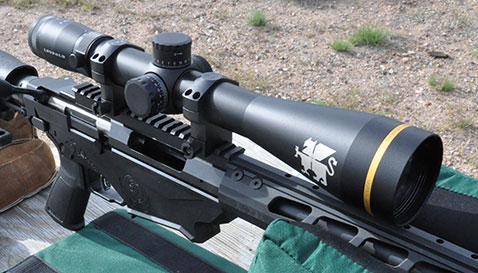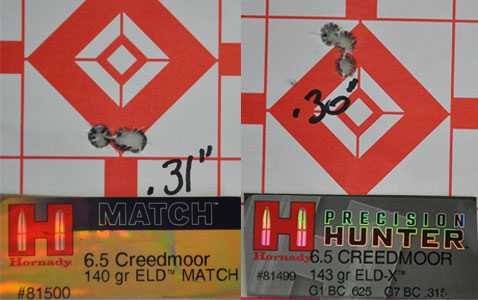 A couple of years ago if I told you there was a precision rifle available for around $1,000 that would shoot groups smaller than one inch at 100 yards all day long you wouldn’t have believed me. The progress in rifle, scope and ammunition development, driven by an interest in long range precision shooting, has resulted in the Ruger Precision Rifle, introduced a year ago, and now, an upgraded version Ruger calls the Enhanced Precision Rifle that shares the features of the original like the light, adjustable trigger, folding stock adjustable for length of pull and height of the comb and the cold hammer forged barrel. Other features of the RPR include the ability to use different magazines – the rifle ships with two, 10 round Magpul PMag magazines – and chamberings in 6.5 Creedmoor and .308 Winchester. The standard Precision Rifle is available in .243 Winchester as well.
A couple of years ago if I told you there was a precision rifle available for around $1,000 that would shoot groups smaller than one inch at 100 yards all day long you wouldn’t have believed me. The progress in rifle, scope and ammunition development, driven by an interest in long range precision shooting, has resulted in the Ruger Precision Rifle, introduced a year ago, and now, an upgraded version Ruger calls the Enhanced Precision Rifle that shares the features of the original like the light, adjustable trigger, folding stock adjustable for length of pull and height of the comb and the cold hammer forged barrel. Other features of the RPR include the ability to use different magazines – the rifle ships with two, 10 round Magpul PMag magazines – and chamberings in 6.5 Creedmoor and .308 Winchester. The standard Precision Rifle is available in .243 Winchester as well.
The folks at Ruger listen to their customers and shortly after the Precision Rifle (RPR) came out shooters began tinkering with them and reporting their results. Because the rifle was designed to be modular it made it easy for owners to switch out parts and add muzzle breaks or suppressors to the threaded barrel so Ruger added a proprietary muzzle break to the enhanced RPR and they replaced the plastic bolt shroud containing a trigger adjustment and bolt takedown tool with an aluminum bolt shroud. Telescopes designed for long range precision shooting are getting bigger all the time; scope tubes have expanded from 1 inch to 30 millimeters, and most recently, 34 millimeters. Objective lenses have increased in size, to the point where there wasn’t enough clearance to mount some of them on the RPR, so Ruger added a fore-end they call the Short Action Handguard without a Picatinny rail on the enhanced RPR to provide clearance for these large scopes.
 Which is a good thing because the folks at the Leupold Custom Shop sent me an incredible scope that wouldn’t have fit on the original RPR, even with extra high rings, due to its huge 56mm objective lens. It’s a Mark 6 with their excellent TMR reticle and a variable power range of 7 – 42 power. Not listed in their catalog, this telescope is an example of the really interesting things the Custom Shop can turn out. They have a new logo, which they applied to this scope, of a Gryphon, representing combining different parts to create something new. Why are scopes getting bigger? Well, for long range shooting the erector assembly in the scope tube has to have enough “up” adjustment to get way out there and the tube has to be bigger to accommodate it. Related to this, high magnification scopes have to transmit a lot of light and a large tube and bigger objective lens get the light into the scope. After that comes the magic of advanced optical engineering and lens coatings, subjects that are way over my head but not to the folks at Leupold who have led the industry for decades and know exactly what they are doing.
Which is a good thing because the folks at the Leupold Custom Shop sent me an incredible scope that wouldn’t have fit on the original RPR, even with extra high rings, due to its huge 56mm objective lens. It’s a Mark 6 with their excellent TMR reticle and a variable power range of 7 – 42 power. Not listed in their catalog, this telescope is an example of the really interesting things the Custom Shop can turn out. They have a new logo, which they applied to this scope, of a Gryphon, representing combining different parts to create something new. Why are scopes getting bigger? Well, for long range shooting the erector assembly in the scope tube has to have enough “up” adjustment to get way out there and the tube has to be bigger to accommodate it. Related to this, high magnification scopes have to transmit a lot of light and a large tube and bigger objective lens get the light into the scope. After that comes the magic of advanced optical engineering and lens coatings, subjects that are way over my head but not to the folks at Leupold who have led the industry for decades and know exactly what they are doing.
 Four variables in precision rifle accuracy are the rifle, the scope, the ammunition and the shooter. Taking me out of the equation, and I’ve always maintained I’m not a very good bench rest shooter, what we have so far is a very accurate rifle, and an exceptional telescope so we’re down to the ammunition. The Hornady 6.5 Creedmoor ammo I’ve been shooting in the original RPR, and now this rifle, is outstanding. The load I started out with is no longer in production, having been replaced by a new ELD (Extreme Low Drag) Match version. Since I had a small stash of this older 140 grain Match load I included it in this test and discovered the two new ELD loads, Match and Hunter, both produced better 100 yard groups in the new rifle. Still, after shooting 18, three shot groups with the three different loads my overall average came out to an outstanding .59 inches. All of the ammunition stayed under the mystical “minute of angle”, or one inch. Groups with the original 140 grain Match load averaged .7”, with the largest being .97” and the smallest shooting into .43”. The new 140 grain ELD Match load averaged .586”, the smallest group shooting into .31” and the largest going .79” (the first two shots in this group went into the same hole, seeing this I pushed the third shot wide.) The surprise of my shooting session came with the results I managed shooting the 143 grain ELD Hunter load. Why surprising? Well, we usually associate hunting ammunition with being less accurate than ammunition advertised as match grade, but in the case of this Hornady ammunition that simply isn’t the case. My shooting produced a smallest group of .30” and a largest of .72”, for an average of only .4875 inches with the ELD Hunter loading.
Four variables in precision rifle accuracy are the rifle, the scope, the ammunition and the shooter. Taking me out of the equation, and I’ve always maintained I’m not a very good bench rest shooter, what we have so far is a very accurate rifle, and an exceptional telescope so we’re down to the ammunition. The Hornady 6.5 Creedmoor ammo I’ve been shooting in the original RPR, and now this rifle, is outstanding. The load I started out with is no longer in production, having been replaced by a new ELD (Extreme Low Drag) Match version. Since I had a small stash of this older 140 grain Match load I included it in this test and discovered the two new ELD loads, Match and Hunter, both produced better 100 yard groups in the new rifle. Still, after shooting 18, three shot groups with the three different loads my overall average came out to an outstanding .59 inches. All of the ammunition stayed under the mystical “minute of angle”, or one inch. Groups with the original 140 grain Match load averaged .7”, with the largest being .97” and the smallest shooting into .43”. The new 140 grain ELD Match load averaged .586”, the smallest group shooting into .31” and the largest going .79” (the first two shots in this group went into the same hole, seeing this I pushed the third shot wide.) The surprise of my shooting session came with the results I managed shooting the 143 grain ELD Hunter load. Why surprising? Well, we usually associate hunting ammunition with being less accurate than ammunition advertised as match grade, but in the case of this Hornady ammunition that simply isn’t the case. My shooting produced a smallest group of .30” and a largest of .72”, for an average of only .4875 inches with the ELD Hunter loading.
I’ll check in again with my progress shooting the enhanced RPR. I’m expecting very good results because how can you go wrong with a great rifle, a great scope and great ammunition?
Check out my previous articles on the RPR and the new ELD Hornady ammunition for more information, as well as Ruger’s website at www.ruger.com., Leupold’s website at www.leupold.com and Hornady’s at www.hornady.com. These sites contain a great deal of information on their products.
For further information on DRTV:
About the Author:
 Ed Head is a regular on Shooting Gallery, Gun Stories and Down Range TV. He has worked for almost 30 years in law enforcement, first in the United States Air Force and then with the United States Border Patrol, retiring as a Field Operations Supervisor. During his Border Patrol career, Ed worked in a variety of patrol, investigative and training capacities. Ed has an extensive background as a firearms instructor, having trained thousands, ranging from beginners to police, military and special operations personnel. Having taught at Gunsite for 20 years, Ed first trained there under the world famous shooting school’s founder, Jeff Cooper, then later ran the school as the operations manager for more than five years. Ed lives in Chino Valley, Arizona, where he continues to teach and write.
Ed Head is a regular on Shooting Gallery, Gun Stories and Down Range TV. He has worked for almost 30 years in law enforcement, first in the United States Air Force and then with the United States Border Patrol, retiring as a Field Operations Supervisor. During his Border Patrol career, Ed worked in a variety of patrol, investigative and training capacities. Ed has an extensive background as a firearms instructor, having trained thousands, ranging from beginners to police, military and special operations personnel. Having taught at Gunsite for 20 years, Ed first trained there under the world famous shooting school’s founder, Jeff Cooper, then later ran the school as the operations manager for more than five years. Ed lives in Chino Valley, Arizona, where he continues to teach and write.
